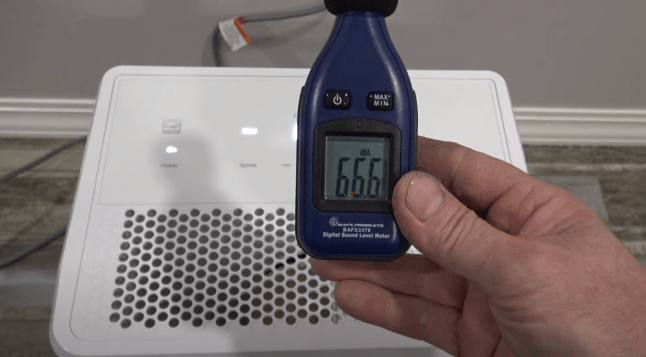Your health and well-being are paramount in the sanctuary of your home. Picture yourself, like countless others, striving for optimal comfort and air quality.
I am Mannan Wasif, your companion in exploring the intricacies and resolving the challenges associated with dehumidifiers. Together, we’ll build a deeper understanding of these vital devices while addressing your concerns.
I am here to guide you on this enlightening journey. My passion lies in unraveling the mysteries and solutions related to dehumidifiers. Over the years, I’ve encountered the same tricks and troubles you may have faced. Questions like, “How many amps does a dehumidifier use?” or “Is my dehumidifier as efficient as it should be?” are just the beginning.
In this blog post, I will unravel the often perplexing world of dehumidifier amperage. Whether you’re a seasoned user or new to the realm of dehumidifiers, understanding power consumption is essential.
We’ll explore how many amps dehumidifiers typically use, what factors influence their electricity consumption, and practical tips to manage their energy usage effectively. By the end of this journey, you’ll have the knowledge to ensure your dehumidifier operates efficiently without compromising your health or energy bills.
How many amps does a dehumidifier use?
Dehumidifiers, those unsung heroes in the battle against humidity, typically draw anywhere between 2.2 and 10.2 amps during operation. But here’s the twist: when you first flip the switch, they can go into a brief amped-up frenzy, peaking at around 27 amps. However, once they settle into their groove, the norm hovers around a more modest 8 amps.
The study investigates a multi-stage planar membrane dehumidifier utilizing Nafion 212 membranes. Operating conditions include 27ºC temperature and 0.1% relative humidity for inlet dry air. The research focuses on the impact of varying temperature, relative humidity, and wet side air flow rate on dehumidification performance, including dehumidification rate (DR), dew point approach temperature (DPAT), pressure loss (ΔP), and pumping power (Ω). Results indicate that higher inlet temperature, relative humidity, and air flow rate improve performance, and counter flow configuration is more effective than parallel flow.
This initial energy surge is a common trait in appliances housing electric motors—think washers and dryers. Dehumidifiers follow suit, expending extra energy as they kickstart their various components, including compressors, coils, and fans.
As they find their rhythm, the power demand settles down, and they operate more efficiently. This variation in energy consumption during startup versus steady operation is worth noting, especially when dealing with industrial or whole-house dehumidifiers. While these heavy-duty champs may require a heftier power supply, standard household models play nice with regular electrical outlets.
Understanding this ebb and flow of energy usage can help you make informed choices when it comes to your dehumidifier’s placement and operation. So, whether you’re battling excess moisture in your basement or seeking a more comfortable living space, your trusty dehumidifier has got the power, literally and figuratively, to make it happen.
Why do some dehumidifiers use more or less power?
The power appetite of a dehumidifier depends on its design and size. Bigger units, crafted to wrangle moisture from expansive spaces, come equipped with larger compressors and refrigeration systems, resulting in higher power consumption.
How Many Amps Does a 22-Pint Dehumidifier Use?

For a 100-volt model 22-pint dehumidifier, the amperage draw hovers around 2.6 amps. In contrast, the 220-volt version requires a mere 1.3 amps.
Don’t let its size fool you; the 22-pint dehumidifier packs a punch. It can efficiently remove up to 22 pints (2.27 liters) of moisture from the air. This makes it a handy companion for smaller spaces like bathrooms, garages, mini-bedrooms, basements, or attics. It’s not a heavyweight, weighing in at 33 pounds, and its portability is a plus, thanks to the built-in wheels.
Moreover, modern models often come with nifty features like self-timers and smartphone compatibility, allowing you to control humidity levels with ease.
How Many Watts is the 35 Pint Dehumidifier?
Running a 35-pint dehumidifier takes approximately 450 watts of energy, debunking the 500-watt myth perpetuated by some manufacturers. With an hourly usage cost of about 16p, this dehumidifier can extract up to 20 liters of moisture per day at 480W, equivalent to 0.48 kWh.
What sets it apart is its speed. Unlike its 22-pint counterpart, the 35-pint dehumidifier can swiftly dry a room in just 30 minutes. It’s the go-to choice for spaces up to 1500 square feet.
How Many Watts Does 70-pint Dehumidifier Need?

A 70-pint dehumidifier typically requires 700 watts of power. It’s a workhorse, capable of dehumidifying spaces as large as 2500 square feet. This makes it a common sight in homes and offices, especially in high-humidity areas like kitchens, bathrooms, and laundry rooms.
However, exercise caution when using it in smaller or enclosed spaces, as its moisture-removal prowess may lead to excessive dryness.
Does a Dehumidifier Require a Dedicated Circuit?
In most cases, standard household dehumidifiers, drawing less than 8 amps, won’t demand dedicated circuits. Ground-fault circuit interrupters (GFCIs) are typically already installed in homes to prevent electrical mishaps. However, it’s prudent to check your home’s circuitry, especially if you have other power-hungry appliances.
Knowing the power requirements of your dehumidifier ensures you can safely share circuits with other devices. Understanding this dynamic can help prevent circuit overload and ensure efficient operation.
Factors Affecting Dehumidifier Power Consumption
Dehumidifier power consumption can vary based on several factors. Understanding these factors can help you use your dehumidifier more efficiently.
- Temperature and Humidity Levels: Dehumidifiers tend to work harder in high humidity and lower temperatures, which can result in increased power usage. If you live in a region with extreme humidity or cold seasons, be prepared for slightly higher energy bills during these periods.
- Dehumidifier Size and Capacity: The size and capacity of your dehumidifier play a crucial role in energy consumption. Larger units designed for bigger spaces may use more electricity. Ensure you select a dehumidifier that matches the size of the room to avoid overconsumption.
- Dehumidifier Age and Condition: Older dehumidifiers may be less energy-efficient than newer models. Regular maintenance and cleaning can help maintain the appliance’s efficiency. If your dehumidifier is getting old and consuming excessive power, it might be time for an upgrade to a more energy-efficient model.
Energy-Efficient Dehumidifier Models
When shopping for a dehumidifier, consider models that prioritize energy efficiency. Look for these features and certifications:
- ENERGY STAR Certification: Dehumidifiers with ENERGY STAR certification meet strict energy efficiency guidelines set by the U.S. Environmental Protection Agency. These models are designed to consume less energy without sacrificing performance.
- Digital Humidity Controls: Dehumidifiers with digital controls allow you to set and maintain your desired humidity level more accurately. This prevents the appliance from running unnecessarily and helps save energy.
- Automatic Defrost: Some dehumidifiers come with automatic defrost features, which can reduce power consumption in colder conditions by preventing frost buildup on coils.
Tips for Optimizing Dehumidifier Energy Efficiency
Follow these practical tips to ensure your dehumidifier operates efficiently:
- Ideal Placement: Position your dehumidifier in a central location within the room for even humidity control. Avoid placing it near obstructions like furniture or curtains, which can hinder airflow.
- Regular Cleaning and Maintenance: Clean the water tank, coils, and air filter regularly as recommended in the user manual. A clean dehumidifier operates more efficiently and consumes less energy.
- Set the Right Humidity Level: Adjust your dehumidifier’s settings to maintain a comfortable but not overly dry indoor humidity level (around 40-50%). Higher humidity settings can lead to unnecessary power consumption.
- Timer Settings: Use the built-in timer feature to run the dehumidifier during specific times when humidity levels are typically higher, such as at night or during rainy periods.
Environmental Impact of Dehumidifiers
Understanding the broader environmental impact of dehumidifiers is essential for conscious consumption:
- Electricity Demand: Dehumidifiers contribute to overall electricity demand, especially in regions with high humidity levels. Higher power consumption from these appliances can strain energy resources.
- Carbon Emissions: Increased electricity demand often leads to higher carbon emissions if the energy source is fossil fuels. Using energy-efficient dehumidifiers and reducing unnecessary usage can help lower your carbon footprint.
- Sustainable Alternatives: Explore sustainable alternatives like solar-powered dehumidifiers or moisture-absorbing desiccants, which have a lower environmental impact.
Conclusion
Choosing the right-sized dehumidifier for your space and performing routine maintenance can optimize its energy efficiency. This means you can enjoy a more comfortable, moisture-free environment without breaking the bank. Here’s to clarity on the energy efficiency of these invaluable appliances.

He is a mechanical engineer & our expert team member with over four years of experience who provides comprehensive and informative guides on various home improvement topics. From DIY projects to professional installations, he strives to give readers the knowledge and tools they need to make informed decisions and successfully complete their home improvement projects.
His goal is to empower homeowners to create the home of their dreams, while also increasing the value and functionality of their property. Whether you’re a first-time homeowner or a seasoned renovator, he has something for everyone.
